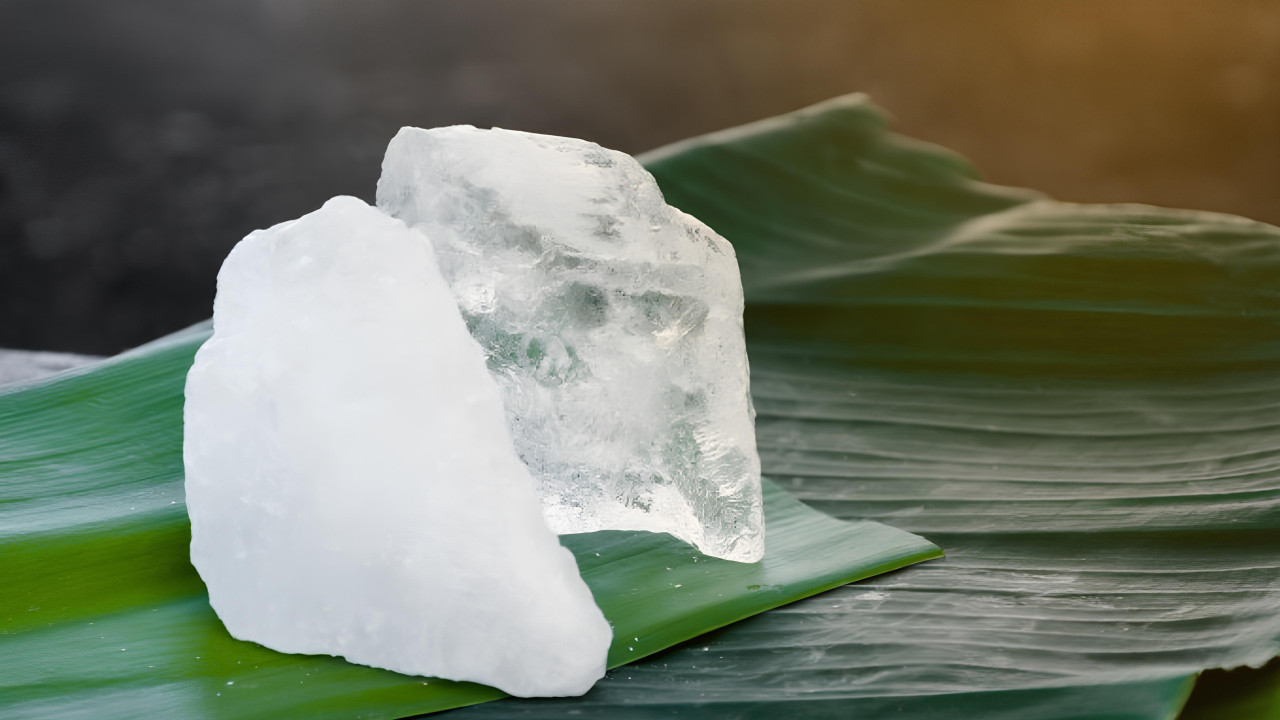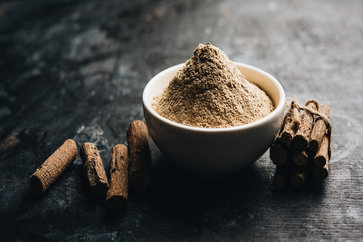Camphor: Uses, Benefits, & Cautions – All You Need to Know
Camphor is a crystalline compound renowned for its distinctive pungent aroma. Primarily extracted from the Cinnamomum camphora tree, it’s obtained through a process involving steam distillation, purification, and sublimation of the plant’s wood and bark.
While camphor itself is the primary constituent, the leaves of this tree also contain a blend of essential oils including linalool, eugenol, safrole, cineol, β-myrecene, nerolidol, camphene, and borneol.
Historically revered for its therapeutic properties, camphor has been employed for centuries in traditional medicine to address a variety of ailments.
Camphor in Ayurveda: A Versatile Remedy
Camphor, known as Kapur in Ayurveda, is a cornerstone ingredient in traditional Indian medicine. It holds a significant place due to its wide range of therapeutic properties.
Ayurvedic Properties of Camphor
- Taste: Bitter, pungent, and sweet
- Virya: Cooling (Sheet Virya)
- Vipaka: Sweet
- Dosha balancing: Primarily balances Pitta and Kapha
Uses of Camphor
Camphor is a versatile substance with medicinal and household applications. It’s commonly used for pain relief, cough relief, and as an antiseptic, while also serving as an insect repellent and aromatic agent. Below are a few uses of them:
1. Uses of Camphor for Respiratory Issues
Camphor has traditionally been used to address respiratory problems due to its potential properties as a decongestant and anti-inflammatory agent.
It may help alleviate congestion, nasal blockage, and cough by soothing irritated airways and reducing inflammation in the lungs and throat.
2. Uses of Camphor for Pain Management
Camphor has been traditionally used for its potential pain relieving properties. When applied topically, it can stimulate nerve endings, creating a cooling sensation that may help alleviate pain and itching.
This desensitizing effect on nerves can also provide temporary relief from acute pain. Additionally, camphor is often used to soothe muscle and joint discomfort.
3. Uses of Camphor for Preventing Low Blood Pressure
Camphor has shown promise in addressing low blood pressure (hypotension) when combined with other substances.
A study involving a mixture of camphor and hawthorn extract (korodin) demonstrated an increase in both systolic and diastolic blood pressure levels.
This suggests that camphor, in conjunction with other components, might have potential as a treatment for hypotension.
4. Uses of Camphor for Managing Osteoarthritis
Osteoarthritis, a degenerative joint disease, occurs when the cartilage cushioning the ends of bones gradually wears away. Camphor has been explored as a potential adjunct therapy for managing osteoarthritis symptoms.
- Pain Relief: Camphor’s analgesic properties may help alleviate joint pain associated with osteoarthritis when applied topically. It creates a cooling sensation that can temporarily distract from discomfort.
- Combined Therapy: Some studies suggest that camphor, when used in combination with other compounds like glucosamine sulfate and chondroitin sulfate, may offer additional benefits in reducing osteoarthritis pain. However, more research is needed to confirm these findings.
Uses of Camphor for Skin
Camphor soothes irritated skin, providing relief from itching and inflammation. It also possesses antibacterial and antifungal properties, aiding in skin healing. Below are a few uses of them:
1. Itching Relief
Camphor’s cooling and soothing properties can provide temporary relief from itching caused by various skin conditions such as insect bites, eczema, and allergic reactions. Its counterirritant effect distracts the brain from the itch sensation, offering comfort.
2. Anti-inflammatory Effects
Camphor possesses anti-inflammatory properties that may help reduce redness, swelling, and discomfort associated with skin conditions like acne, psoriasis, and dermatitis. It can help calm irritated skin and promote healing.
3. Acne Treatment
Some people find camphor beneficial in managing acne due to its potential antibacterial and anti-inflammatory actions. It may help reduce the number and severity of acne lesions by targeting the bacteria responsible for breakouts.
4. Minor Skin Injuries
Camphor’s antiseptic properties can help prevent infection in minor cuts, scrapes, and abrasions. It creates a protective barrier on the skin, reducing the risk of contamination.
5. Skin Conditioning
Camphor is often included in skincare products due to its potential skin-conditioning benefits. It can help improve skin texture, reduce dryness, and give the skin a refreshed appearance. However, it’s crucial to use camphor-based products in moderation, as excessive use may cause irritation.
How to Use Camphor?
Camphor is commonly found in various forms, each with its own application:
1. Camphor Balm
- Common use: Chest rubs for cough relief.
- Application: Apply a generous amount to the chest and throat, and cover with a warm cloth for better absorption.
Caution: Avoid contact with eyes, nose, and mouth.
2. Camphor Oil
Versatile use: Can be used for pain relief, skin conditions, and aromatherapy.
Application:
- Pain relief: Dilute with a carrier oil like coconut or olive oil and massage into sore muscles or joints.
- Skin conditions: Mix a few drops with a moisturizer for itchy skin.
- Aromatherapy: Add a few drops to a diffuser or hot water for inhalation.
Caution: Always dilute camphor oil before applying it to the skin.
3. Camphor Cream
- Common use: Skin irritations and itching.
- Application: Apply a thin layer to the affected area as needed.
Caution: Avoid prolonged or excessive use.
General Precautions:
- Camphor is for external use only. Avoid ingestion.
- Do a patch test before using camphor on a large area of skin.
- Keep camphor products out of reach of children.
- If you experience any adverse reactions, discontinue use and consult a healthcare professional.
Side Effects of Camphor
Side Effects of Camphor, Camphor, while offering potential benefits, can also pose significant risks, especially when misused or ingested.
Severe Toxicity: Accidental ingestion, particularly by children, is extremely dangerous and can lead to:
- Hepatotoxicity (liver damage)
- Neurotoxicity (damage to the nervous system)
Skin and Eye Irritation: Direct contact with camphor can cause irritation to the skin and eyes.
Acute Toxicity: Inhalation or excessive skin exposure can result in:
- Muscular excitability (tremors, twitching)
- Nausea and vomiting
- Headache and dizziness
- Seizures
- Delirium
It’s crucial to handle camphor products with extreme caution and keep them out of reach of children. If you suspect camphor poisoning, seek immediate medical attention.
Interactions with Other Drugs
Camphor can interact with certain medications, especially those that affect the liver. Combining camphor with hepatotoxic drugs (medications that can damage the liver) can increase the risk of liver injury.
It’s crucial to inform your healthcare provider about all medications, supplements, and herbal remedies you’re taking, including camphor-containing products. This includes both prescription and over-the-counter drugs.
Always prioritize the advice of your healthcare professional. They can assess your specific health condition and provide guidance on safe and appropriate use of camphor.
Frequently Asked Questions
1. What is camphor?
Camphor is a waxy, white, or transparent solid with a strong aromatic odor. It is derived from the wood of camphor laurel (Cinnamomum camphora) trees.
2. How is camphor used?
Camphor can be used in various forms:
- Topical: It is applied to the skin to relieve pain and itching.
- Aromatic: It is used in vaporizers or inhalants for its soothing aroma.
- Internal: In some cultures, it is ingested in very small amounts for medicinal purposes, although this is not recommended without medical supervision.
3. What are the potential benefits of camphor?
Camphor may help with respiratory issues like congestion and cough, relieve pain and inflammation, treat skin conditions, and provide relaxation and stress relief.
4. Are there any safety concerns with camphor?
Yes, camphor can be toxic if ingested in large amounts. It should not be used internally without proper medical guidance. Topical use should be in moderation and diluted as per instructions to avoid skin irritation.
5. Can camphor be used for children?
It is not recommended to use camphor on children, especially in forms that could be ingested or applied directly to the skin, due to the risk of toxicity and skin irritation.
6. Is camphor safe during pregnancy and breastfeeding?
Pregnant or breastfeeding women should consult their healthcare provider before using camphor, as safety considerations may vary.
7. Where can camphor be purchased?
Camphor products are available at pharmacies, health food stores, and online retailers. It is important to ensure you are purchasing from reputable sources.
8. Can camphor interact with medications?
Yes, camphor may interact with certain medications or exacerbate certain medical conditions. It is crucial to discuss its use with a healthcare professional if you are taking any medications or have underlying health concerns.
9. What is the recommended dosage of camphor?
The dosage of camphor varies depending on the form and intended use. For topical applications, it should be diluted according to instructions to avoid adverse effects. Oral ingestion should only be done under the guidance of a healthcare provider, as even small amounts can be toxic.
10. Can camphor be used for aromatherapy?
Yes, camphor is commonly used in aromatherapy for its calming and decongestant properties. It can be used in vaporizers or diffusers to create a soothing atmosphere.
11. Does camphor have any traditional uses?
Camphor has a long history of traditional use in various cultures. It has been used for religious rituals, as a moth repellent, and in traditional medicine for its therapeutic properties.
12. What are the side effects of camphor?
Common side effects of camphor include skin irritation, allergic reactions, and respiratory distress if inhaled in large quantities. Ingestion of camphor can lead to nausea, vomiting, and seizures in severe cases.
13. Is camphor addictive?
No, camphor is not addictive. It does not produce dependency or withdrawal symptoms when used appropriately for its intended purposes.
14. Can camphor be used as a disinfectant?
Camphor has mild antimicrobial properties and has been used historically as a disinfectant for surfaces. However, it is not as effective as modern disinfectants and should not be relied upon solely for this purpose.
15. How should camphor products be stored?
Camphor products should be stored in a cool, dry place away from direct sunlight and heat. Keep them out of reach of children and pets to prevent accidental ingestion.
Note: If you have any further questions about camphor or its uses, consulting with a healthcare professional or pharmacist is advisable for personalized advice.
References:
- Phytochemistry and Applications of Cinnamomum camphora Essential Oils(1)
- Camphor ( Cinnamomum camphora ), a traditional remedy with the history of treating several diseases(2)
- Camphor (Cinnamomum camphora), a traditional remedy with the history of treating several diseases(3)
- Camphor: Benefits and risks of a widely used natural product(4)


























